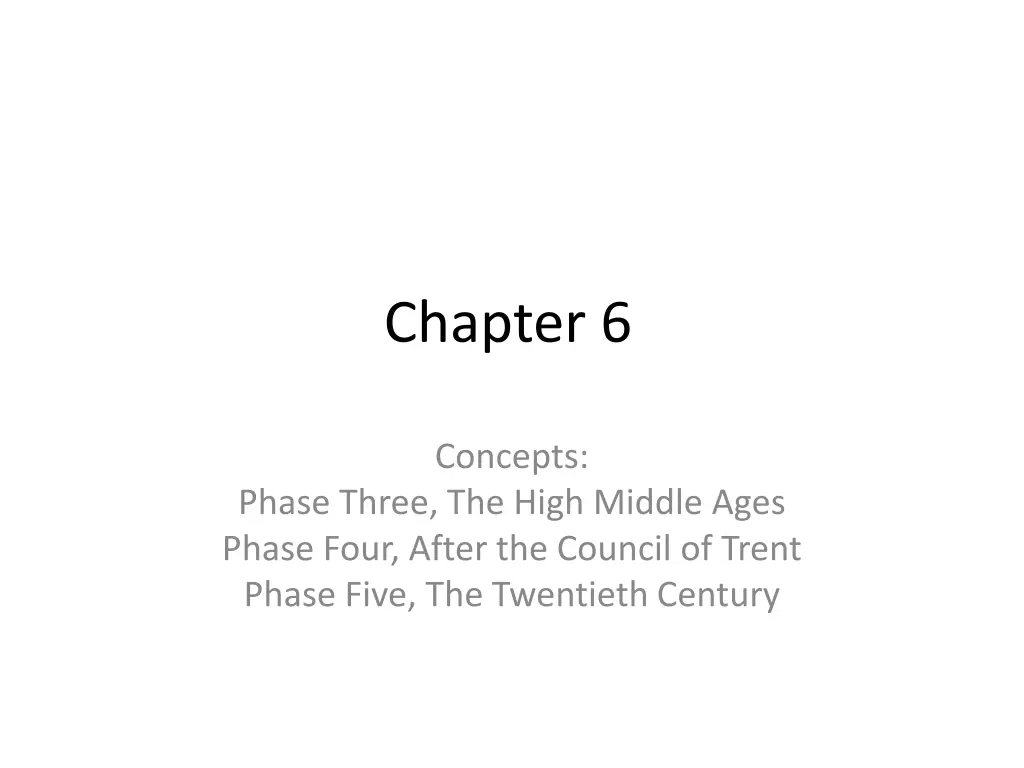
Key Phases in Christian Church History: High Middle Ages to 20th Century
Explore the significant phases in Christian Church history, from the formality of the High Middle Ages to the reforms post the Council of Trent and the impacts leading up to the 20th century with the Second Vatican Council.
Download Presentation

Please find below an Image/Link to download the presentation.
The content on the website is provided AS IS for your information and personal use only. It may not be sold, licensed, or shared on other websites without obtaining consent from the author. If you encounter any issues during the download, it is possible that the publisher has removed the file from their server.
You are allowed to download the files provided on this website for personal or commercial use, subject to the condition that they are used lawfully. All files are the property of their respective owners.
The content on the website is provided AS IS for your information and personal use only. It may not be sold, licensed, or shared on other websites without obtaining consent from the author.
E N D
Presentation Transcript
Chapter 6 Concepts: Phase Three, The High Middle Ages Phase Four, After the Council of Trent Phase Five, The Twentieth Century
Phase Three, The High Middle Ages Formality and relative stability marked the years between 1000 and 1300. Feudal European culture was most synonymous with the Christian Church of the West Second Council of Lyons identified the 7 official sacraments of the church
Continued St. Thomas Aquinas taught that sacraments are causes of God s grace. The church began to emphasize correct form in sacramental rituals in order to prevent abuses and confusion. This encouraged a superstitious attitude towards religion and the sacraments. Despite the church s teachings against magical thinking.
Continued This attitude and abuses of the sacraments and other church became to widespread that is sparked a religious revolution known as the P__________________ R________________
Phase Four: After the Council of Trent The Protestant Reform movement first aimed to reform the ____________ Church from within. It ended up organizing itself into various denominations. These denominations denied the pope s central authority, for political as well as religious reasons.
Continued The Catholic church called the Council of Trent in the mid 16thcentury. They added reforms of their own to avoid abuse. The council reaffirmed the validity of all 7 sacraments They distinguished between the sacraments and sacramentals. Sacramentals can be defined as devotional or pious practices or holy objects that can be spiritually enriching.
Phase four continued Approved a scholastic understanding of the sacraments. They emphasized that sacraments are causes of Grace and necessary for salvation. Sacramentals became increasingly popular. No further changes in the church s official teachings and practices were made until almost 400 years later at the
Phase Five: The 20thCentury Second Vatican Council. Was prompted by Catholic Scholars examination of Christianity s biblical roots, early church worship and the teaching of Aquinas. This began a renewal in the church. The church realized the theology and practices had been changing throughout history.
continued The church reclaimed aspects of its Tradition that had been de-emphasized. It also dropped aspects that clouded the sacraments true spirit. The changes in sacraments called for by the council aim to reveal Jesus more clearly.
Pam Stenzel Discussion
